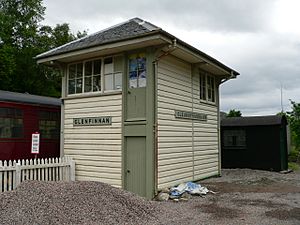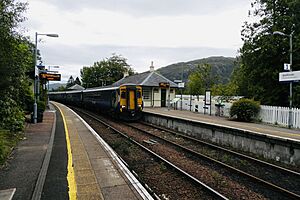Glenfinnan railway station facts for kids
Quick facts for kids
|
|
|---|---|

The platforms at Glenfinnan in August 2022, looking west
|
|
| Location | Glenfinnan, Highland Scotland |
| Coordinates | 56°52′21″N 5°26′58″W / 56.8725°N 5.4495°W |
| Platforms | 2 |
| Other information | |
| Station code | GLF |
| History | |
| Original company | Mallaig Extension Railway of West Highland Railway |
| Pre-grouping | North British Railway |
| Post-grouping | LNER |
| Key dates | |
| 1 April 1901 | Station opened |
| Traffic | |
| Passengers (2019/20) | |
| Passengers (2020/21) | |
| Passengers (2021/22) | |
| Passengers (2022/23) | |
| Passengers (2023/24) | |
|
Listed Building – Category B
|
|
| Designated | 29 May 1985 |
| Reference no. | LB312 |
Glenfinnan railway station is a train station in the village of Glenfinnan, located in the Highland area of Scotland. It is a stop on the famous West Highland Line, a scenic railway route. The station is situated between the Lochailort and Locheilside stations.
Just a short distance from the station is the Glenfinnan Viaduct, a stunning bridge that has appeared in several Harry Potter movies. All train services at the station are run by ScotRail.
Contents
History of the Station
Glenfinnan station first opened to the public on 1 April 1901. It was built as part of the Mallaig Extension Railway, which extended the West Highland Line to the port of Mallaig.
Unique Architecture
The station buildings have a special "chalet style" design. This look was created by the Scottish architect James Miller. He designed many of the stations along this railway line. The buildings were constructed by Robert McAlpine's company using a strong material called mass concrete.
The station has two platforms, one on each side of the track, allowing trains to pass each other. This is known as a crossing loop. There are also extra tracks called sidings on the south side of the station.
Camping Coaches
From the 1930s to the 1960s, Glenfinnan was a place where you could find "camping coaches." These were old railway carriages that were converted into simple holiday homes. Families could rent them and stay right next to the railway line. The LNER first placed a coach here from 1936 to 1939. After a break, they returned from 1952 until 1969.
How the Railway Was Kept Safe
When the railway first opened, it used a system called the electric token system to make sure only one train was on a section of track at a time. Glenfinnan had its own signal box with 15 levers to control the signals and points. The signal box was located at the east end of the southbound platform.
Over the years, the signalling system was updated. In 1987, the old system was replaced with the Radio Electronic Token Block (RETB). This modern system uses radio signals to control train movements. The RETB is managed from a control centre at Banavie. This change meant that the signal box at Glenfinnan was no longer needed and was closed.
Glenfinnan Station Museum
Today, the main station building is home to the Glenfinnan Station Museum. The museum tells the story of how the Mallaig Extension Railway was built and its importance to the area.
Inside, you can see the restored ticket office with its original equipment. There are also displays about the local area, a gift shop, and a changing exhibition of railway photographs. The museum is open during the main tourist season.
The museum site, including the old signal box, was refurbished in 2011 and 2012. This work made the buildings better for visitors and helped preserve their history.
Station Facilities
Platform 1 has a waiting room, a bench, a help point for information, and racks for bicycles. The car park is next to this platform and has step-free access.
To get to Platform 2, passengers must use one of two barrow crossings over the tracks. There are no ticket machines at the station, so passengers need to buy tickets before they travel or from the guard on the train.
Train Services
On weekdays, there are usually four trains a day to Mallaig and three trains to Glasgow Queen Street. There is also an evening train to Fort William that connects with the Caledonian Sleeper service to London Euston.
On Sundays, there are typically three trains per day in each direction.
| Preceding station | Following station | |||
|---|---|---|---|---|
| Locheilside | ScotRail West Highland Line Fort William and Mallaig route |
Lochailort | ||
| Historical railways | ||||
| Locheilside Line and Station open |
North British Railway Mallaig Extension Railway of West Highland Railway |
Lochailort Line and Station open |
||



